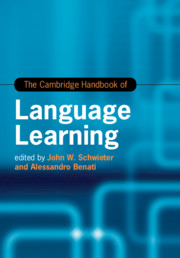Book contents
- The Cambridge Handbook of Language Learning
- Cambridge Handbooks in Language and Linguistics
- The Cambridge Handbook of Language Learning
- Copyright page
- Contents
- Figures
- Tables
- Contributors
- Acknowledgements
- Introduction
- Part I Theories
- Part II Methods
- Part III Skill Development
- Part IV Individual Differences
- Part V Pedagogical Interventions and Approaches
- Part VI Context and Environment
- Part VII Moving Forward
- Index
- References
Part III - Skill Development
Published online by Cambridge University Press: 25 June 2019
- The Cambridge Handbook of Language Learning
- Cambridge Handbooks in Language and Linguistics
- The Cambridge Handbook of Language Learning
- Copyright page
- Contents
- Figures
- Tables
- Contributors
- Acknowledgements
- Introduction
- Part I Theories
- Part II Methods
- Part III Skill Development
- Part IV Individual Differences
- Part V Pedagogical Interventions and Approaches
- Part VI Context and Environment
- Part VII Moving Forward
- Index
- References
Summary
Cognitive interactionists claim that interaction provides valuable opportunities for learners to refine and restructure their interlanguage by drawing their focal attention to linguistic code features during negotiation for meaning (see Gass, 1997, 2003; Gass & Mackey, 2006, 2015; Long, 1996, 2007; Mackey, 2012; Mackey, Abbuhl, & Gass, 2012; Pica, 1994, 1996). Negotiated interaction activates cognitive learning processes that involve processing (modified) input, receiving corrective feedback (CF), and producing (modified) output, during which learner attention is directed to L2 linguistic features, leading to noticing and in turn L2 development. Over two decades of empirical research designed to explore the link between interaction and actual learning has yielded abundant evidence that clearly indicates that interaction precipitates L2 learning (see Mackey, 2012 for a review of interaction research; Keck et al., 2006 and Mackey & Goo, 2007 for meta-analytic reviews of early interaction-acquisition studies).
- Type
- Chapter
- Information
- The Cambridge Handbook of Language Learning , pp. 231 - 362Publisher: Cambridge University PressPrint publication year: 2019



